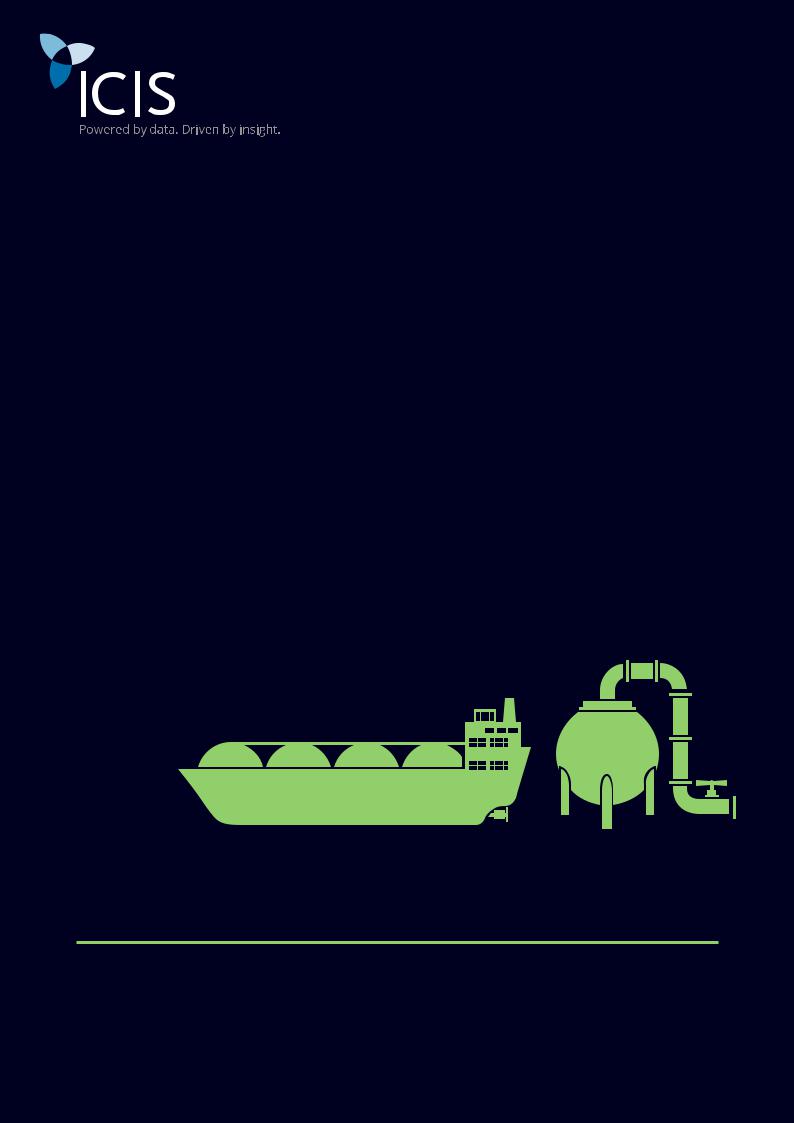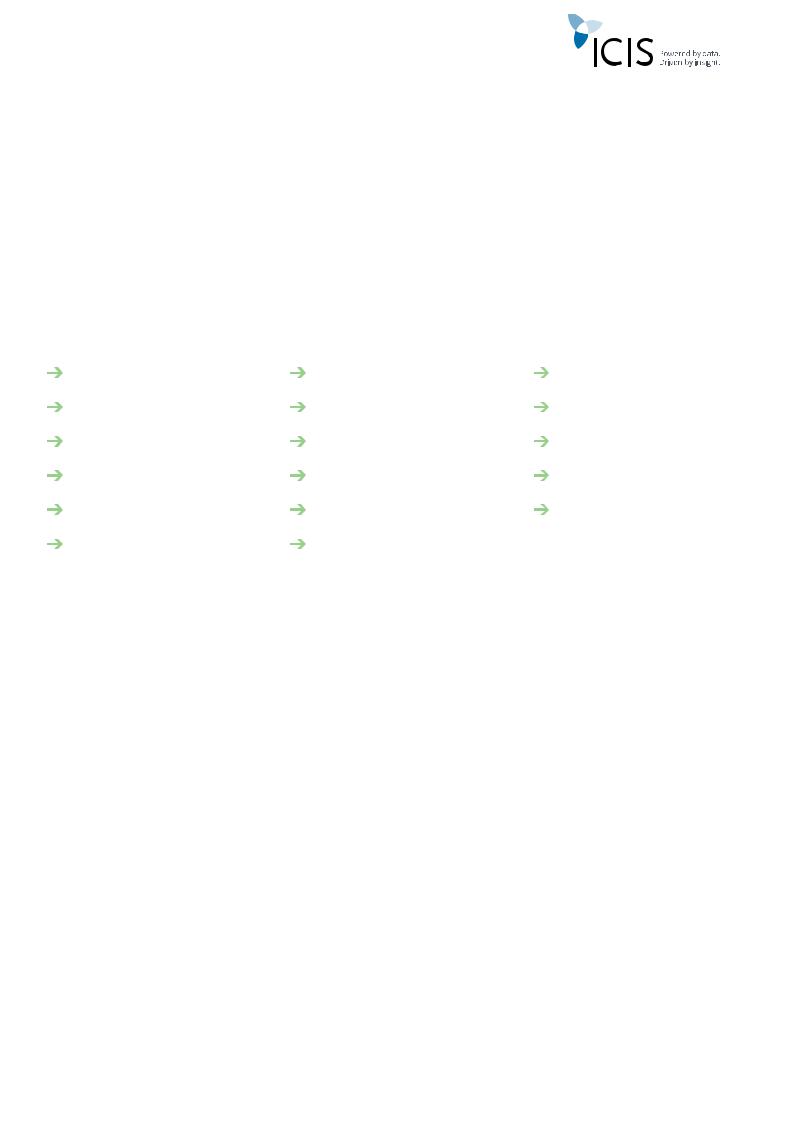
ICIS_Global_LNG_Market_Outlook_2019_watermark
.pdf
vk.com/id446425943
GLOBAL
LNG
OUTLOOK 2019
The ICIS Outlook
Australia should become established as the world’s largest LNG exporter
Japan’s demand will most likely stagnate
European gas hub prices could remain at a narrow discount to premium Asian markets
North America will boost its standing as an LNG exporter, alongside Russia
China will boost reliance on imports
Challenges on LNG demand will persist from South America, while Europe could be favoured

vk.com/id446425943
CONTENTS
AUSTRALIA |
THAILAND |
EUROPE |
CHINA |
MALAYSIA |
IBERIA |
JAPAN |
INDONESIA |
MIDDLE EAST |
SOUTH KOREA |
SINGAPORE |
AFRICA |
INDIA |
NORTH AMERICA |
RUSSIA |
TAIWAN |
SOUTH AMERICA |
|
|
|
|

vk.com/id446425943
GLOBAL LNG OUTLOOK 2019
SUMMARY
China will remain the key growth market globally and LNG imports will continue to climb in 2019, as the rise in domestic gas demand absorbs LNG, domestic gas and pipeline imports.
On production, Australia’s emerging role as the world’s largest LNG exporter should be cemented in 2019 with the last of the current phase in new export projects ramping up.
Japanese LNG demand is expected to remain stagnant or decline, as nuclear generation gains a larger share of the power mix, while India’s spot LNG demand should increase following the commissioning of three new LNG import projects and the start-up of a new pipeline connecting the Kochi terminal to the big demand centres.
In southeast Asia, Thailand will make progress this year on its ambition to become a regional LNG hub. Growth in US LNG export capacity will be a key feature of 2019, with several final investment decisions expected to materialise.
Political risk looks likely to cast doubt on new South American demand.
Europe’s robust LNG import activity should continue, with flexible volumes arriving from the US, Peru and Trinidad, together with more Russian volumes flowing to Europe from Yamal. In the Middle East, Egypt will double down on its new found net exporter status.
AUSTRALIA
■Australian production could top 78m tonnes
■Optimisation opportunities for traders
With the recent start of production at three new LNG projects in Australia, the country should become the world’s largest LNG exporter over 2019 as a whole.
Anglo-Dutch major Shell’s Prelude formally commenced operations on 25 December, 2018.
Wheatstone LNG, operated by US-based Chevron alongside Australia’s Woodside, along with Inpex’s Ichthys LNG, could raise Australian exports to over 78m tonnes, according to the LNG Edge supply forecast.
The wave of Australian exports will introduce additional gas to Asian buyers as spot opportunities are likely to emerge on the back of extra production, gaps in annual delivery programmes and optimisation opportunities.
The ongoing US-China trade dispute will likely mean that at least some of the new supply will be used to swap US Gulf cargoes for Australian volumes, not only to avoid tariffs but also to optimise on transportation costs.
Growing competition on the short-term markets in Asia will likely introduce additional liquidity to the market and higher churn ratios on traded supply.
However, the market expects to see a higher level of participation from new entrants, which could result in the absorption of at least some of the additional supply.
CHINA
■Growth driven by city gas companies
■Third-party access boost for LNG
China, the world’s second largest LNG importer, could see imports could hit around 70m tonnes in 2019, according to ICIS estimates. This follows imports of almost 54m tonnes in 2018, up by 41% on 2017.
Import growth has mainly been driven by city gas companies purchasing a large amount of LNG as a supplement to pipeline gas.
With improving gas pipelines in urban areas, demand from the city gas sector will continue to grow in 2019.
China’s focus on environmental protection will prompt large industrial users to replace coal with natural gas in 2019, boosting demand.
The role of long-distance gas pipelines will not change much in 2019 and this will support LNG demand.
The China-Russia gas pipeline will only start trials at the
back to contents
Copyright 2019 Reed Business Information Ltd. ICIS is a member of RBI and is part of RELX Group plc. ICIS accepts no liability for commercial decisions based on this content.

vk.com/id446425943
end of 2019. China is likely to still depend on LNG imports to meet incremental gas demand, and will again be a focal point for sellers looking for long-term LNG buyers.
The share of LNG imports in the gas mix is set to increase further to around 32% in 2019 from 26% in 2018.
More LNG capacity will be released from the three Chinese terminals which came on stream in 2018.
China’s total current LNG import capacity is 65mtpa. Shenzhen Gas’ 600,000tonne/year terminal and HuaFeng Group’s 1mtpa terminal are likely to come on stream in 2019.
Spot LNG cargoes bought by China in the international market mostly originate from Australia.
Chinese buyers may increase their purchases if spot prices drop to around $7/MMBtu at the end of the first quarter of 2019.
China’s LNG consumption in 2019 will also be bolstered by ongoing reforms to the natural gas market but concerns persist over economic growth rates.
KEY ASIAN LNG PRODUCTION FORECAST, 2019
Million tonnes
50
 Australia
Australia  Malaysia
Malaysia  Indonesia
Indonesia  Russia - Sakhalin
Russia - Sakhalin
45
|
Papue New Guinea |
|
Brunei |
|
|
||
|
|
40 |
|
|
|
35 |
|
|
|
30 |
|
|
|
25 |
|
|
|
20 |
|
|
|
15 |
|
|
|
10 |
|
|
|
5 |
|
|
|
0 |
|
|
|
Q1 |
Q2 |
Q3 |
Q4 |
Source: ICIS LNG Supply Forecast
TRADE TRUCE PERIOD CONTINUES BETWEEN US AND CHINA
The US and China are currently in a so-called “truce period” in trade discussions, after the leaders asked for a 90-day cooling off period, which ends 1 March, 2019.
This period is expected to bring more clarity for US LNG developers, which up until late last year were chasing after prospective Chinese buyers with the outlook for burgeoning Chinese gas demand. China’s PetroChina is the only company with a firm sales and purchase agreement with Cheniere for US LNG.
However, sources have said that Venture Global is expected to advance with prospective Chinese buyers - but the trade war has been a hindrance.
JAPAN
■Stagnant demand forecast
■Contractual LNG oversupply
Japanese LNG demand is expected to remain stagnant or to decline in 2019, as nuclear generation gains a larger share of the power mix.
Gas-fired generation is also facing some competition from renewables, while a dent in oil prices could weigh on gas demand from the industrial sector.
Nuclear availability ended last year at the highest since the Fukushima accident in early 2011, as four 1.2GW reactors were restarted between March and June 2018. A temporary court injunction barring the operation of an 890MW reactor was also lifted in late September.
The prospects for further nuclear restarts are uncertain, but industry sources have indicated at least one additional reactor could restart by March 2020.
At the same time, Japan is nearing a peak in contractual supply, most notably with the 8.9mtpa Ichthys project
in northern Australia in ramp-up, with about 70% of its production destined for Japanese customers.
The start-up of US export projects Freeport and Cameron will add to Japanese contractual oversupply, with the likelihood that some of these volumes will be diverted to other markets.
Due to this contractual length, Japanese buyers are seeking shorter contracts, smaller volumes and more flexible terms.
As a latest example, trading entity JERA entered an agreement with Abu Dhabi’s ADNOC LNG, which is to replace a contract for 4.3mtpa expiring by the end of March, with a deal for 0.5mtpa over the next three years.
With a ban on destination restrictions in new deals, Japanese buyers are likely to become increasingly active on the sell-side as companies seek to manage contractual oversupply.
SOUTH KOREA
■Threat from coal-fired generation
■Demand growth uncertain
After a record year in 2018, the momentum of South Korean LNG demand growth will be tested in 2019.
Displacement from competing fuels in the power sector remains a key factor in the short term, despite government
back to contents
Copyright 2019 Reed Business Information Ltd. ICIS is a member of RBI and is part of RELX Group plc. ICIS accepts no liability for commercial decisions based on this content.

vk.com/id446425943
targets to increase the use of gas-fired generation by 2030.
Nuclear availability has now largely stabilised, after extended maintenance and enhanced safety checks pushed it to historical lows through the first half of 2018.
Some issues still remain around cracks in containment buildings at the Hanbit nuclear plant, which have resulted in delays in the return from maintenance of four reactors.
A similar concern involving a Korean-built plant in the UAE could also impact the schedule of new reactors at Shin-Kori and Shin-Hanul, which were previously expected to start in 2018 but have since been pushed to late 2019.
It also remains to be seen whether government policy will be sufficient to curb coal-fired generation, after a spate of new generators were completed in 2016-2017.
Several older units are required to shut down on an annual basis between March and June and the government has also introduced a measure to cap production during periods of high air pollution
KEY FORWARD PRICES FOR 2019
$/MMBtu |
|
|
|
|
|
|
15 |
Henry Hub |
US FOB |
ICIS East Asia Index |
|
||
|
|
|||||
|
NBP |
|
TTF |
ICIS Japan contract price |
||
12 |
|
|
|
|
|
|
9 |
|
|
|
|
|
|
6 |
|
|
|
|
|
|
3 |
|
|
|
|
|
|
0 |
February |
March |
April |
May |
June |
July |
|
||||||
Note: US FOB is Henry Hub *1.15+$2.50/MMBtu
INDIA
■Indian buyers to rely on spot for new demand
■Liberalisation of gas market to continue
India’s spot LNG demand is likely to increase in 2019 following the commissioning of three new import projects and the start-up of a new pipeline connecting Petronet’s Kochi LNG terminal to the main demand centres.
The Ennore, Mundra LNG and H-Energy FSRU project near Mumbai are all expected to be supplied from the spot market.
State-owned Indian Oil has no underlying supply contract for its Ennore LNG facility on the east coast of the country.
The project is likely to be supplied through a series of short and mid-term tenders once starting full commercial operations later this year.
The Mundra LNG project, promoted by the Adani Group, is also likely to be supplied on the basis of short-term volumes.
The facility currently lacks pipeline connections with the main centres of demand. But a connecting pipeline, built by state-owned GSPC, is likely to come onstream at some point later this year.
Adani is currently in discussions with several suppliers about short-term options for the Indian market.
Independent H-Energy is also looking for supplies in addition to the mid-term contract signed with Malaysia’s state-owned PETRONAS.
But the company is yet to aggregate sufficient downstream supply to justify significant new commitments in terms of LNG supplies. Adani’s total demand will depend on the attractiveness of LNG against competing fuels, such as naphtha and fuel oil.
Any significant fall in crude oil prices could render LNG less attractive.
In parallel with international developments, India is expected to liberalise further segments of its domestic gas market in 2019, leading to greater demand from the industrial, power and commercial sectors, particularly in Gujarat.
back to contents
Copyright 2019 Reed Business Information Ltd. ICIS is a member of RBI and is part of RELX Group plc. ICIS accepts no liability for commercial decisions based on this content.

vk.com/id446425943
TAIWAN
■Demand growth slowing
■Limited receiving capacity
While imports to Taiwan may have reached as high as 17m tonnes in 2018, the growth trajectory still showed signs of slowing down and may take a reverse course in 2019.
Like South Korea, the policy direction is in favour of more gas-fired generation, with a target set at 50% of the power mix by 2025, up from around 40% currently.
As part of this plan, power incumbent Taipower plans to commission its second 893MW unit at the Tungshiao gasfired power plant in May.
However, these ambitions are for the time being constrained by Taiwan’s limited LNG receiving capacity. A third terminal is scheduled for completion in 2023.
Tight power supply margins also resulted in the decision to restart the 985MW No 2 reactor at the Kuosheng power plant in June 2018 after a two-year shutdown. This should result in greater nuclear availability in 2019, despite
the decommissioning of Taiwan’s two oldest reactors in December 2018 and July 2019.
Both reactors have been unavailable for extended periods.
THAILAND
■Progress towards an LNG hub?
■New LNG trading team
A few milestones in Thailand’s ambitions to become a southeast Asian LNG hub are planned for 2019.
Power incumbent EGAT intends to become the country’s second LNG importer, making use of third-party access rules to receive its first cargo by September.
The company has secured 1.5mtpa of capacity at the Map Ta Phut terminal, with operator PTT having already completed works to expand from 10mtpa to 11.5mtpa to accommodate the new buyer. According to PTT, the commissioning process for the additional capacity will largely depend on EGAT’s timeline, which is yet to be finalised in detail.
PTT also aims to step up its spot activity in 2019, with the launch of a new LNG trading team. Initial focus will be on optimisation around its existing contract portfolio, with swaps or the sale of contracted cargoes floated as a possibility.
PTT has so far been able to use the flexibility of existing supply agreements to keep imports below its combined contractual commitment of 5.2mtpa.
Imports are expected to increase from around 4.5mtpa in 2018 to around 5mtpa in 2019. As such, the company’s target for spot purchases at around 20% of overall LNG imports remains an ambition for later years.
MALAYSIA
■Unplanned outages forecast
■PETRONAS to move its floating liquefaction unit
A TRUSTED SOURCE FOR LNG MARKET INTELLIGENCE, LIVE PRICES AND INTUITIVE ANALYTICS
The LNG market is changing constantly and is becoming increasingly harder to predict. We believe that in order to respond quickly to the market you need a robust and unique combination of deep datasets and intuitive analytical tools.
OUR ANALYTICS ALLOW YOU TO:
νKeep on top of developments in the market
νPredict the impact of current and future events across every port
νGet a long-term view of future contracts, rates and supplier performance
νGain greater visibility and a complete view of global supply
νMake faster chartering and trading decisions, with real-time cargo tracking
Learn more
back to contents
Copyright 2019 Reed Business Information Ltd. ICIS is a member of RBI and is part of RELX Group plc. ICIS accepts no liability for commercial decisions based on this content.

vk.com/id446425943
Malaysian exports may be vulnerable to unplanned maintenance for much of 2019, as high production at the gas fields offshore Sarawak will still have to be maintained to mitigate reduced flows via the SabahSarawak pipeline.
Although the flows have resumed, the pipeline is expected to undergo integrity assurance tests over the first half of 2019, which means feedgas volumes to the Bintulu LNG project are likely to remain marginal.
Malaysian producer PETRONAS is still expected to offer spot volumes at various points throughout the year. The company’s contractual portfolio shrunk by around 6mtpa in 2018, with new supply agreements with Indian buyer H-Energy and Chinese major CNOOC covering only a small portion of that volume.
Sources at PETRONAS have indicated that it will move its floating liquefaction facility PFLNG 1 to the Kebabangan gas field in the second quarter. The move should enable gas from the field offshore Sabah to be liquefied and exported, without having to rely on the overland pipeline connection to the Bintulu LNG project in Sarawak.
INDONESIA
■Bontang expected to offer uncommitted volumes
■Status of new agreements still uncertain
Indonesian exports remained fairly stable in 2018, with a record 132 shipments from the 7.6mtpa Tangguh LNG project in West Papua taking up the slack from weak production at the Bontang LNG project in Borneo.
State-owned Pertamina has struggled to meet production targets at the Mahakam gas fields, which is the main source of feedgas to Bontang.
Extended maintenance also seems to have cut exports significantly in the second half of 2018.
While Pertamina aims to minimise the decline in production at Mahakam over the next five years, there has been little indication that the company is drilling enough wells to meet its targets.
The Jangkrik gas field has provided an alternative source of supply since mid 2017, while the Merakes field is expected to begin production in 2020, which should provide some additional replacement volumes.
Bontang is nonetheless expected to offer uncommitted volumes in 2019, with the status of new supply agreements with Pakistan and Bangladesh still uncertain. Domestic demand is also yet to recover to its peak of 2016, causing
Pertamina to divert some offtaker commitments from Australian and US LNG.
SINGAPORE
■Fifth storage tank progress
■LNG reload rise
Having commissioned a fourth storage tank in 2018, Singapore LNG (SLNG) issued an expression of interest to assess market demand for a fifth tank in December. Successful bidders will be invited to participate in a request for proposal to be issued by SLNG at a later date.
Both Switzerland-based trader Trafigura and Singaporebased energy company Pavilion Gas have secured storage and reload agreements, with reloads reaching a record of 11 cargoes in 2018. This was up by one compared to the previous year.
CHINA’S LNG PUSH
The majority of LNG imports are shipped to China’s state-owned majors, but this is changing: smaller Chinese firms are stepping up to import more directly, instead of through the majors. This gives them more supply security and enables cost savings.
Security of supply is an issue for smaller firms because when supply is tight the majors will divert gas and LNG to the residential sector, cutting supply to other customers.
In 2019, firms will bid for auctioned import slots to gain access to state-owned major CNOOC’s terminals. CNOOC is expected to offer 70-110 service windows for LNG imports at its subsidiary terminals, to be traded on the Shanghai Petroleum and Natural Gas Exchange.
Third-party buyers can only deliver the cargoes in liquid form via truck. As such, truck-delivered LNG imports are expected to cover over 60% of the country’s overall domestic LNG supply in 2019, up from 53% in 2018, according to ICIS estimates.
NORTH AMERICA
■US brownfields advance toward FID
■Uncertainty over Mexico’s Pemex
Brownfield projects in the US with planned expansions are seen as the most likely ventures to next take FID in 2019, given the more competitive construction cost benefits and reputation of the operators.
Cheniere’s Train 6 at Sabine Pass is expected to take FID soon, sources said.
Qatar Petroleum and ExxonMobil’s Golden Pass is also
back to contents
Copyright 2019 Reed Business Information Ltd. ICIS is a member of RBI and is part of RELX Group plc. ICIS accepts no liability for commercial decisions based on this content.

vk.com/id446425943
soon expected to financially sanction.
Sources at the time said the overall project cost was likely being recalculated following a revision in US steel tariffs.
While greenfield project developers such as Tellurian and NextDecade have crowdfunded from investment firms toward their respective projects in Lousiana and Texas, there have not been any binding sales and purchase (SPA) agreements from greenfield developers.
The only exception is US-based Venture Global, which is developing Calcasieu Pass in Louisiana and has signed contracts.
Sources said Venture Global was expected to advance with prospective Chinese buyers, but the current stand-off between the China and US has stalled those negotiations.
In Mexico, another Pemex group is still planning its own floating import facility in order to import natural gas as LNG and use the gas for associated recovery, following Pemex’s earlier scrapping of an FSRU plan.
The timeline for such an import project is uncertain, as well as the ability for Pemex to execute on its own without project financing.
In Canada, challenges lie ahead. The Shell-led LNG Canada project cleared the final investment hurdle in October 2018, but the pipeline route of the associated Coastal GasLink is now under scrutiny from indigenous protestors.
The two-train, 14mtpa project in Kitimat, British Columbia, is the first to reach FID on the west coast of North America.
Secondary marketing is well underway by the stakeholders in the Canada LNG project.
These include Japanese buyers Toho Gas and Tokyo Gas, which have Heads of Agreement in place with Mitsubishi’s subsidiary Diamond Gas International (DGI) for a combined 0.9mtpa.
Japanese buyers JERA and Chugoku also have agreements with Mitsubishi for Canada LNG offtake, sources said.
In November 2018, Switzerland-headquartered Vitol signed for 0.8mtpa of LNG from PETRONAS for a 15-year term, on both a free-on-board (FOB) and delivered basis.
The volumes will come from Canada and other sources of PETRONAS’ supply
US LNG EXPORTS FOCUS ON Q4
Million tonnes
16
14 |
|
12 |
|
10 |
|
8 |
|
6 |
|
4 |
|
2 |
|
0 |
|
Q1 |
Q2 |
|
Sabine Pass |
|
Cove Point |
|
|
||
|
|
Q3 |
 Corpus Christi
Corpus Christi
Q4 |
Elba |
|
Cameron |
|
Freeport |
|
Yamal |
|
|
|
|||
|
|
|
Source: ICIS LNG Supply Forecast
Monitor how LNG supply is changing worldwide, up to two years ahead
The ICIS LNG Supply Forecast lets you understand changes, event impact and compare adjustments to identify new opportunities.
νGet real-time market updates on events that shape the forecast
νUse the monthly granularity and real time adjustments to ensure your forecasting is robust
νDigest and interrogate information quickly with our consolidated service and visualisations
See it in action
back to contents
Copyright 2019 Reed Business Information Ltd. ICIS is a member of RBI and is part of RELX Group plc. ICIS accepts no liability for commercial decisions based on this content.

vk.com/id446425943
SOUTH AMERICA
■Competition from renewables
■Political risk grows
New LNG demand in the Americas could take longer than expected to come online, particularly as Latin American countries grapple with changes in government, competition for renewables and the nascent development of liberalised gas markets.
In Argentina, plans are underway to bring in a floating liquefaction barge by Belgian shipping company Exmar for Argentina’s state-run energy company YPF.
The companies estimated an ambitious timeline of operations by May 2019.
Many in the Americas are sceptical of this switching over to an exporter, considering that Argentina still needs imports for its southern hemisphere heating season.
Argentina’s state-run gas distributor IEASA also may reconsider the return of its FSRU to Bahia Blanca this year.
In Brazil, the new administration of incoming president Jair Bolsonaro could result in some delays to the country’s fledgling gas reforms.
While a series of decrees were announced by hydrocarbons regulator ANP in December 2018, market sources said ANP must still flesh out the regulations and develop the framework around Brazil’s gas reforms.
Brazil’s first private FSRU is expected by many to arrive in 2019, although the Sergipe power complex is delayed for another year.
EUROPE
■Robust flow of LNG to Europe in 2019
■Poland to take more US cargoes
A relatively weak oil price environment and an oversupplied global LNG market could mean European gas hub prices remain at a narrow discount to premium Asian markets in 2019.
The volume of LNG imported from the Americas as a percentage of imports is likely to increase, as volumes from the US, Peru and Trinidad will head to opportune European markets including Britain, France, the Netherlands and Belgium. This will allow sellers to manage their portfolios by harnessing European capacity, especially at times of lower seasonal East Asian demand.
As Russia’s Yamal train 3 ramps up, more Russian cargoes will also flow to Europe. If low demand in Asian markets persists, these are likely to be delivered for consumption in European markets rather than reloaded or trans-shipped.
The need for outright reloads from Europe will depend on global price spreads and shipping costs. LNG supplies may also continue exerting downward pressure on front and second month gas prices at European hubs, as traders price out risk premiums on ample supplies.
Within Europe, the NBP premium to the TTF could sustain interest from LNG sellers to Britain. Declining northwest European gas production and major summer storage injection could mean prices in the region no longer trade at such a substantial discount to markets in the south.
Structurally, Poland is emerging as a significant buyer of US
Receive the latest spot price assessments for Europe’s major and emerging natural gas hubs
The daily European Spot Gas Markets report (ESGM) ensures you have the most up-to-date spot price assessments, expert analysis of developments and detailed supply/demand trade flows to help you gauge market activity in traded natural gas.
WITH ESGM YOU CAN:
νEstablish a direct spot price reference
νUnderstand market moving developments
νIdentify new opportunities
νAnalyse risks and make accurate price comparisons
Try our benchmark report today 
back to contents
Copyright 2019 Reed Business Information Ltd. ICIS is a member of RBI and is part of RELX Group plc. ICIS accepts no liability for commercial decisions based on this content.

vk.com/id446425943
and Qatari LNG as it moves away from Russian pipeline gas.
Greek LNG demand may also see more US cargoes flow to the newly enlarged Revithoussa terminal, which is likely to switch from spot cargoes to contractual supplies.
IBERIA
■Reloads from Iberia likely to stay unviable
■Reforms could enter force in 2019
Having been burnt in previous years by being long on LNG at the end of winter, traders in Iberia have been anxious to avoid a potential oversupply as the first quarter of 2019 unfolds.
This has resulted in fewer scheduled LNG imports to Spain this winter than previously. Spanish shippers would usually expect to be able to shed length by selling on the global market. But waning prices throughout much of the last half of 2018 also made this option less practical.
Reloads from Iberia – which are more expensive than at other European terminals – have not been viable. In 2019, this will probably continue.
Looming reform of Spain’s LNG sector, needed to deal with uneven terminal usage, does have the potential to change Spain’s role in this area, however. These reforms could enter force this year, but may run over into 2020.
Looking to the back end of 2019, the picture emerging from the PVB gas hub, where prices relative to other European hubs for summer delivery have been weakening, is that supply is likely to be very comfortable. This could eat into demand for spot LNG demand from Spanish buyers this year.
The weaker premium relative to the benchmark TTF is also now a feature of the front calendar year at the PVB, which points to a relaxed supply outlook in 2020.
Following the start of US LNG flows into Spain in 2017 by Spanish incumbent Naturgy, further contracts have the potential to increase the US share of the Spanish LNG import mix.
The next contract to enter force in 2019 will be the 1.5mtpa deal between Spanish power incumbent Endesa and US supplier Cheniere.
Although FOB, it seems likely that some of the volumes may find their way into Iberia, adding to the range of new US volumes, as well as those coming from Yamal.
SOUTHERN EUROPE DOMINATES REGIONAL TERMINAL UTILISATION
12-month terminal utilisation,%
80 |
|
|
|
|
|
|
|
|
|
70 |
|
|
|
|
|
|
|
|
|
60 |
|
|
|
|
|
|
|
|
|
50 |
|
|
|
|
|
|
|
|
|
40 |
|
|
|
|
|
|
|
|
|
30 |
|
|
|
|
|
|
|
|
|
20 |
|
|
|
|
|
|
|
|
|
10 |
|
|
|
|
|
|
|
|
|
0 |
|
|
|
|
|
|
|
|
|
Adriatic |
Swinoujscie, |
Fos Tonkin, |
Montoir, |
Bilbao, |
Gate, |
||||
LNG, Italy |
Poland |
|
|
France |
France |
|
|
Spain |
Netherlands |
Fos Cavaou, |
Sines, |
ETKI LNG |
Marmara, |
Zeebrugge, |
|||||
France |
Portugal |
Terminal, Turkey |
|
Turkey |
|
Belgium |
|||
Source: ICIS LNG Edge
MIDDLE EAST
■Egypt to boost exports
■Demand to fall in Jordan and UAE
Bahrain will join the club of LNG importers from February when its new FSU, the Bahrain Spirit, begins operations.
Officials have told ICIS that Bahrain LNG will rely almost exclusively on the spot market to procure supplies to meet domestic demand, particularly in the summer when consumption peaks for air conditioning.
Egypt will double down on its new found net exporter status. The country’s exports overtook imports in September 2018, and are expected to total around 3.9m tonnes in 2019, according to the LNG Edge supply forecast.
Demand in Jordan and the United Arab Emirates will continue to fall. After relying in recent years on a steady
back to contents
Copyright 2019 Reed Business Information Ltd. ICIS is a member of RBI and is part of RELX Group plc. ICIS accepts no liability for commercial decisions based on this content.
